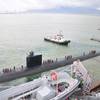Arctic melting slowed enough in midsummer that scientists don't expect this year's sea ice minimum to set a new record. This year’s melt season in the Arctic Ocean and surrounding seas started with a bang, with a record low maximum extent in March and relatively rapid ice loss through May.
The melt slowed down in June, however, making it highly unlikely that this year’s summertime sea ice minimum extent will set a new record.
“Even when it’s likely that we won’t have a record low, the sea ice is not showing any kind of recovery. It’s still in a continued decline over the long term,” said Walt Meier, a sea ice scientist at NASA’s Goddard Space Flight Center in Greenbelt, Maryland.
Walt added: “It’s just not going to be as extreme as other years because the weather conditions in the Arctic were not as extreme as in other years.”
“A decade ago, this year’s sea ice extent would have set a new record low and by a fair amount. Now, we’re kind of used to these low levels of sea ice – it’s the new normal.”
As scientists are keeping an eye on the Arctic sea ice cover, NASA is also preparing for a new method to measure the thickness of sea ice – a difficult but key characteristic to track from orbit.
"We have a good handle on the sea ice area change," said Thorsten Markus, Goddard’s cryosphere lab chief. "We have very limited knowledge how thick it is."
Arctic sea ice has varied terrain in the summer months, as ridges and melt ponds form and floes break apart. A new NASA satellite called ICESat-2, launching in 2018, will measure the height of sea ice year-round.












